Text
Ambarkanta: The Shape of the World as envisioned by Matej Cadil is one of the fan made maps featuring in this article.

Tolkien cared very much for the geography of his second world, which extended to making multiple maps to help him visualize place and nail down details such as travel times. This proclivity has passed on to many of his fans. Many of us recall poring over the map in our first copy of The Lord of the Rings or flipping frequently to the back of of The Silmarillion to find a location on its map.
For other fans, Tolkien's cartography has inspired them to build beyond what he gave us by making their own maps of his world. @anerea-lantiria's new series within the Tolkien Fanartics column focuses on fan-made maps of Tolkien's world. In the first part, she looks at maps that detail the building of Arda and of Aman, areas that, compared to the well-trodden paths of the Lord of the Rings, Hobbit, and even Silmarillion maps, require a lot more digging, conjecture, and imagination. In addition to finding stunning examples of maps of Tolkien's earliest legendarium, @anerea-lantiria spoke with several artists about how they envision the maps they make, blending Tolkien's canon with their own imaginings.
You can read Anérea's "Mapping Arda, Part I: Terraforming" here, published by @silmarillionwritersguild.
32 notes
·
View notes
Text
Featuring this unusual illustration by Simon Cook. You can find out more about this artwork here.
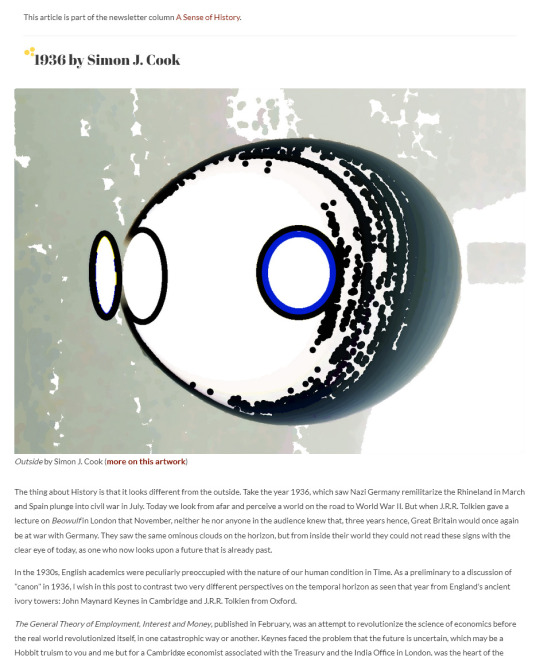
When we look at Tolkien's work today, we look at it from the vantage point of 2023. We see the trajectory of his decades of work on the legendarium. We see, within a historical context, texts that seem to respond to or even predict what would have been the breaking news of the day.
In this edition of A Sense of History column, Simon J. Cook continues his series of articles on the tower analogy found in Tolkien's pivotal essay "Beowulf: The Monsters and the Critics," considered even today to be the most important scholarship penned on Beowulf. Simon makes the case that the tower analogy present in the essay has connections to the legendarium: that the tower-builder climbs his tower to look upon the same sea that so seduces the characters of the legendarium, separating Middle-earth from Valinor. From the view from his tower, the man glimpses the wisdom of a lost world, but to do so requires imagination.
In 1936, when he delivered "Monsters and the Critics" (and was also in the midst of some of his most productive work on the "Silmarillion" materials), Tolkien would have been grappling with a world again on the brink of war and all of the fear and uncertainty that provoked. Much like the Beowulf-poet and the man and his tower, he turned to the past for answers and for courage.
You can read the complete article here, published by @silmarillionwritersguild
#a sense of history#silmarillion meta#swg art#tolkien fanart#tolkien fandom#tolkien fanworks#silmarillion fanart#beowulf
3 notes
·
View notes
Text
Featuring this stunning art by @welcometolotr

The work that would eventually be published as The Silmarillion has deep roots, having been first written down in the 1910s when Tolkien was still a young man fighting in World War I and beginning his career as a philologist. The earliest work on the "Silmarillion," published as The Book of Lost Tales, is a collection of characters, events, and ideas that, like mayflies, often survived only briefly beyond their birth before being replaced or stricken altogether. Ómar-Amillo is one such character, appearing only in the Lost Tales before Tolkien took his thoughts in a new direction.
This biography discusses the brief appearance of Ómar, who was a music god (along with several others ... part of the reason he possibly didn't stick around for long). As the brother of Salmar, Ómar illustrates the importance of music and the oral tradition in the legendarium, but his character and its eventual disappearance both also show how Tolkien's ideas about Arda aligned (and didn't) with the myths, legends, and histories of the peoples who inspired much of his work.
You can read Ómar's biography here, published by @silmarillionwritersguild.
#character bio#artists on tumblr#book of the lost tales#tolkien fanart#swg art#silmarillion writers guild#silmarillion fanart#swg#tolkien fandom#tolkien fanworks#silmarillion meta
6 notes
·
View notes
Text
Featuring this fluffy and lovely art by @astral-aromance

Some of fanfiction's most beloved ideas, pairings, and details were never so much as imagined, much less written down, by Tolkien. Fanon, or fan-generated ideas and details, pervade fanworks, but these details are more than just inventions or even personalized touches added to the legendarium. In many cases, they are the fruits of conversations carried across decades.
Yet fanon hasn't always enjoyed a comfortable acceptance in all corners of the Tolkien fanfiction fandom. At times, despite its ubiquity, it has been dismissed as frivolous or even harmful to Tolkien's legacy. Yet evidence suggests these viewpoints have shifted over time.
In this Cultus Dispatches article, Dawn uses Tolkien Fanfiction Survey data to consider fanon and fan-generated ideas more broadly. Looking at both how readers and writers view fanon, she reveals shifting attitudes as the fandom matures.
You can read Talking amongst Ourselves: Tolkien Fanfiction and Fanon here, published by @silmarillionwritersguild
#cultus dispatches#fandom studies#silmarillion writers guild#silmarillion fanart#tolkien fanworks#artists on tumblr#tolkien fanart#swg art#swg#tolkien fandom
6 notes
·
View notes
Text
Featuring fierce and gory art by @anerea-lantiria

Wolves populate the shadows of much of Western folklore, and Tolkien’s legendarium—ladling as it does from that Cauldron of Story—is no exception. Draugluin is one of several wolves or wolfish beings who appear in Tolkien’s stories: the lord of the werewolves. Although only briefly appearing, his presence in the story is a memorable one, as he challenges (and is slain by) Huan, and his skin is used by Beren to sneak into Angband.
In this biography of Draugluin, @naryaflame explores not only the evolution of his character in the legendarium (hint: he was early-appearing but in very different form) but the folkloric roots that Tolkien may have drawn from … and those he definitely did not. As is often the case with Tolkien, Narya finds deep roots in language and lore that helped inform the character of Draugluin.
You can read the biography of Draugluin here, published by @silmarillionwritersguild.
#swg art#tolkien fanart#character bio#artists on tumblr#tolkien fandom#silmarillion meta#silmarillion writers guild#silmarillion fanart#tolkien fanworks#swg
11 notes
·
View notes
Text
Featuring @ylieke's incredible art like this portrait of Sauron

Ringed by wordless faces, the portrait room in an art museum has a certain hush to it. There is the human face, many times over, a deceptively simple theme. Yet within those faces, lines hint at past pain. Eyes flash from a face defined by age or youth. The best portraits seem to capture just a moment in a story passing on either side of that brief second in time. It is possible to imagine what happened leading up to the portrait and what transpired after. The impeccable, impressionistic paintings of Ylieke seem to belong in such a gallery. Although Ylieke describes her work as centered on storytelling, these are not complicated action scenes. Instead, it is the eyes, the hands, the faces of her characters that speak to what they are feeling and experiencing in that moment, leaving no doubt that there is a rich story happening on either side of it.
In our latest Tolkien Fanartics column, firstamazon @ettelene (Tumblr) caught up with Ylieke to learn more about her technique, goals, and beliefs as a fan artist. Interestingly, Ylieke describes her own work as, "not so good at drawing emotions," with which this viewer would strongly disagree. However, no matter what you creative form of choosing, Ylieke's careful look at her own work and approach to art might be useful advice: "Sometimes illustrations just don’t come out as they were envisioned. The best course of action in this case is to finalize the work as well as you can and move on. The next work will be 0.001% better."
You can read firstamazon's interview with Ylieke here: https://www.silmarillionwritersguild.org/node/6965, published by @silmarillionwritersguild.
P.S. If you'd like to get our weekly email newsletter, you can subscribe here. Each week's edition includes fanworks added to the SWG that week, SWG news, and a rundown on ongoing events around the Tolkien fandom ... and of course our regular columns like Tolkien Fanartics, Character of the Month, a Sense of History (real-world comparisons), Cultus Dispatches (Tolkien fan studies) and more!
#swg art#silmarillion writers guild#tolkien fanart#tolkien fandom#artists on tumblr#artist interview#tolkien#silmarillion fanart
20 notes
·
View notes
Text
Article by @thedaughterofshadows, photograph by @dawnfelagund.

Diversity in the works and fandom of J.R.R. Tolkien has been a topic of much discussion in recent years as recognition grows that Tolkien's "mythology for England" is read by far more than the English ... or English speakers even. The Tolkien fan community is an international one, with fans from every inhabited continent on the globe bringing their perspectives to bear on the legendarium. Within this international community, Tolkien fans belong to myriad identity groups, some of them marginalized in both Tolkien's and the real world. Significant media coverage devoted to the diverse casting of Amazon's Rings of Power series rocketed these discussions—once limited to some fannish and scholarly enclaves—into the realm of popular discourse.
The 2021 Tolkien Society Seminar on the theme "Tolkien and Diversity" was therefore timely. The best-attended seminar to date, Tolkien and Diversity has now been published as a book containing some of the papers delivered at the seminar. In our latest Read & Review column, Shadow takes a look at the proceedings and what they have to offer to the Tolkien fan who is interested in the topic. They conclude that the proceedings balance discussion of the international fan community with papers about marginalized identities and provide a summary of each paper before offering advice to potential buyers about whether the book is a good addition to their Tolkien collection.
You can read Shadow'a review of Tolkien and Diversity here, published by @silmarillionwritersguild.
#swg art#tolkien fanart#tolkien society#tolkien society seminar#tolkien and diversity#swg read & review
3 notes
·
View notes
Text
Find out more about this fascinating artwork here by Simon J. Cook.

This article of A Sense of History coloumn continues Simon J. Cook's series on Tolkien's renowned lecture-turned-essay "Beowulf: The Monsters and the Critics." Roundly considered to be a watershed moment in Beowulf studies, Tolkien uses an extended metaphor of a tower, some stones, and coterie of friends and neighbors to comment on the state of Beowulf criticism in 1936.
What often goes overlooked is that the people in the tower analogy were in fact real people: Tolkien's colleagues and fellow scholars, whose ideas about Beowulf he harbored various feelings about. In this month's column, Simon looks at an old draft of "Beowulf: The Monsters and the Critics," which presents a simplified version of the tower analogy and sheds some light on whom the various figures in the metaphor represent.
You can read the entire article here , published by @silmarillionwritersguild.
#swg art#tolkien fanart#silmarillion fanart#silmarillion writers guild#tolkien fandom#a sense of history#tolkien meta#beowulf#beowulf: the monsters and the critics
1 note
·
View note
Text
Article and illustration by Simon Cook. You can find out more about this intriguing Palantir art here

Back in 2009, Angelica considered the Anglo-Saxon influences in The Silmarillion in her article Beowulf in Beleriand. In this month's A Sense of History column, Simon J. Cook turns that concept on its head, considering in what ways Tolkien saw Beleriand in Beowulf, namely the "northern feeling" described by so many readers of Tolkien's First Age work, where history grinds toward a seemingly inevitable decline and loss. Simon considers specifically the metaphor of the tower, present in Tolkien's influential 1936 lecture "Beowulf: The Monsters and the Critics," where a man uses old stones to build a tower to gaze upon the sea. The sea, Simon argues, is the unknown that has been forgotten by the Anglo-Saxons in Beowulf—or the "wise talkers" of Middle-earth who look back in nostalgic half-remembrance to a drowned world.
You can read the article here, published by @silmarillionwritersguild.
#swg art#silmarillion writers guild#tolkien fanart#artists on tumblr#silmarillion meta#a sense of history#beowulf#beowulf: the monsters and the critics#tolkien fandom#tolkien meta#tolkien
5 notes
·
View notes
Text
Featuring this stunning and amazing art by @ismeneee
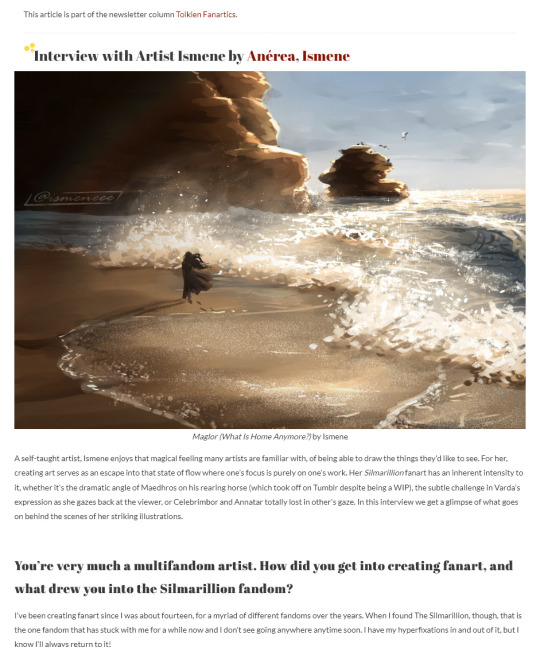
Tolkien artist @ismeneee illustrations and character portraits fairly leap off of the screen ... or now the page. Ismene's artwork was recently featured on the cover of the Tolkien Society Seminar proceedings for Tolkien and Diversity. Since Shadow recently reviewed this volume, we hoped that Ismene would chat with us about what it's like to be a self-taught Tolkien fan artist whose work was chosen for the proceedings of the best-attended Tolkien Society Seminar, and she kindly obliged.
In this Tolkien Fanartics, @anerea-lantiria spoke with Ismene about the draw (pardon the pun!) of The Silmarillion as an inspiration of fan art, her creative process, and of course the Tolkien character she would meet in person if given the chance. You can read Anérea's interview with Ismene here.
You can read the interview with this incredibly talented artist here, published by @silmarillionwritersguild.
#swg art#tolkien fanart#silmarillion fanart#silmarillion writers guild#artists on tumblr#tolkien fanartics#tolkien society seminar#tolkien fanworks
13 notes
·
View notes
Text
Featuring this amazing art by Mina (@matrose). Article by @dawnfelagund
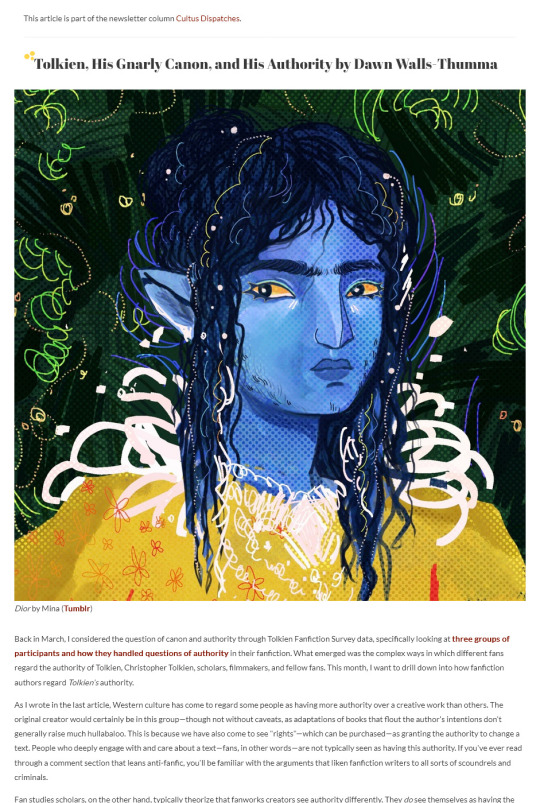
Back in March, I considered the question of canon and authority through Tolkien Fanfiction Survey data, specifically looking at three groups of participants and how they handled questions of authority in their fanfiction. What emerged was the complex ways in which different fans regard the authority of Tolkien, Christopher Tolkien, scholars, filmmakers, and fellow fans. This month, I want to drill down into how fanfiction authors regard Tolkien's authority.
As I wrote in the last article, Western culture has come to regard some people as having more authority over a creative work than others. The original creator would certainly be in this group—though not without caveats, as adaptations of books that flout the author's intentions don't generally raise much hullabaloo. This is because we have also come to see "rights"—which can be purchased—as granting the authority to change a text. People who deeply engage with and care about a text—fans, in other words—are not typically seen as having this authority. If you've ever read through a comment section that leans anti-fanfic, you'll be familiar with the arguments that liken fanfiction writers to all sorts of scoundrels and criminals.
You can read the full article here published by @silmarillionwritersguild.
6 notes
·
View notes
Text
Featuring art from @anerea-lantiria, article by @dawnfelagund
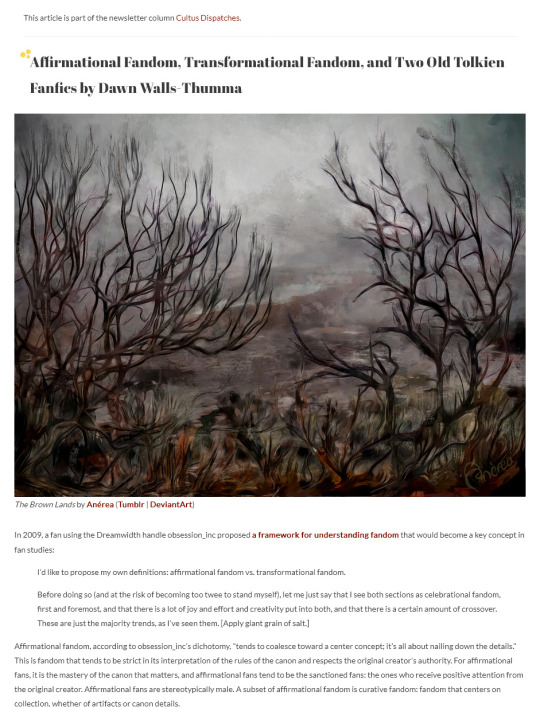
Although Star Trek and media fandom are often credited as the beginning of fanfiction, the first fanfiction texts are much older than that and oriented in book fandoms. (The first fanfics are older even than the term fanfiction!) The first two known Tolkien fanfics appeared in the 1960 fanzine I Palantir, and they couldn't be more different.
This Cultus Dispatches column from @silmarillionwritersguild analyzes these two old fics, in particular how they illustrate the fan studies concept of affirmational and transformational fandom. Transformational fandom is often depicted as the fertile field where fanworks grow, but Tolkien fanworks (and probably many other fandoms' fanworks as well) defy this, drawing on affirmational elements oriented in mastery of canon and consideration of Tolkien's authority. The earliest Tolkien fanfics not only show how both "types of fandom" can give rise to fanworks but how, even in fanworks that clearly belong to one or the other, elements of the other fandom approach are essential to making a particular story work.
You can read the article "Affirmational Fandom, Transformational Fandom, and Two Old Tolkien Fanfics" here.
40 notes
·
View notes
Text
Arda during the Years of the Lamps envisioned by @soluscheese, article by @dawnfelagund

Tolkien's canon is complicated. That's an understatement. There are dozens of books presenting multiple versions—some of them contradictory, difficult to date, and sometimes hard to even read—and that's before one considers the many adaptations, fanworks and fan interpretations, scholarship, and myriad other "takes" on Middle-earth.
This Cultus Dispatches column is one of our Fandom Voices columns, where we present a question or two to the community in an attempt to capture a range of fan experiences with a topic. We asked participants how they define canon and, if they make fanworks, how they use that canon in their fanworks. We received a record number of responses, many of them going into great depth, and so this iteration of Fandom Voices is divided into two columns, beginning with how fans define Tolkien's canon. However, you can read all of the responses together here.
How Tolkien fans define canon mirrors the complexity of the canon itself. We agree on very little (although many people noted the value of different approaches and the importance of tolerance), but the result is a decades-strong fandom where vibrant discussion and creative interpretation of the legendarium have lulled but never completely ceased. Respondents wrangled with how to handle the canon's many contradictions, the place of Christopher Tolkien's editorial work, the historical and mythical framework of the legendarium and the impact of that approach, and where adaptations and fanworks belong in terms of canon, among many other issues raised and discussed.
You can read the first part of "Fandom Voices: Defining Canon and Using Canon in Fanworks" here, published by @silmarillionwritersguild
Also note that our Fandom Voices surveys never close. If you didn't get a chance to share your views and want to, it is not too late! We will continue to add new responses to the collection as they come in (including pulling from new responses for the second part of the article. You can respond to the "Defining Canon" survey here.
Finally, we are in the midst of a series of Cultus Dispatches articles focusing on canon in the Tolkien fandom. Cultus Dispatches is always open to contributions from all members of the fandom, so if you know of a creator or fanwork that takes an interesting approach to canon, or if you have another idea related to canon and fandom, contact our moderators and pitch your idea! Our reference editors will support new researchers and writers through the process, so don't let unfamiliarity with research writing dissuade you from sharing your ideas with us.
#tolkien fandom history#fandom history#fan studies#swg newsletter#cultus dispatches#artists on tumblr#soluscheese#arda
21 notes
·
View notes
Text
Maria Filatova @rittare's beautiful painting of Húrin, lord of Dor-lomin, illustrates the second half of Húrin's biography by @melestasflight.

In the first half of Húrin's biography, @melestasflight makes the case that he is a prototypical hero within the legendarium, a character who possibly inspired Third Age heroes like Aragorn. In the biography's second half, Húrin's life takes a turn for the tragic. (But of course! It is The Silmarillion!)
Húrin might have one of the rawest deals in a book of raw deals. After sacrificing himself so that Gondolin could survive, he experiences physical and psychological torment in Morgoth's hands, helplessly watches the tragic demise of his family, and once freed, goes forth not to a hero's welcome but to mistrust and a series of betrayals. Melesta teases out the elements of this part of the story that have deeper historical and literary resonances, including what Húrin's story tells us of heroism.
You can read Part 2 of Húrin's biography here, published by @silmarillionwritersguild
#hurin thalion#silmarillion writers guild#swg art#swg#tolkien fanart#tolkien fandom#tolkien fanworks#silmarillion fanart#character bio#character biography#tolkien meta#silmarillion meta#artists on tumblr#fanartists on tumblr#rittare#melestasflight
11 notes
·
View notes
Text
Featuring art by fanartist @lycheesodas, article by @dawnfelagund

Over the past few months our Cultus Dispatches column has been looking at issues of how Tolkien fans define and use canon. This article by @dawnfelagund looks at Tolkien Fanfiction Survey data around five possible canon authorities: Tolkien himself, other fans, scholars and experts, Christopher Tolkien, and Peter Jackson and other filmmakers. What emerges from looking at these five survey items is that the matter of canon and authority is complex. Fans vary—and widely—in who they regard as an authority and how that impacts their practice, but a few trends emerge, which Dawn looks into in some detail.
You can read the column "Who Gets to Say? Canon and Authority" here, published by @silmarillionwritersguild
We are also collecting responses on the question "How do you define Tolkien's canon?" for our Fandom Voices project. You can learn more about the project and contribute your response here.
30 notes
·
View notes
Text
call for art!
Our upcoming character of the month will be Amlach, the Man who had been impersonated by a servant of Morgoth at a council, speaking out against the Elves, and who thereafter went to Himring in the service of Maedhros, saying "I have now a quarrel of my own with this Master of Lies, which will last to my life's end".
Do you have an artwork depicting him, or would you like to create one for his bio? We'd love to hear from you!
Thanks!
12 notes
·
View notes
Text
@mangez-peches-art's sweet art of Húrin and his youngest daugter, Lalaith (laughter), in happy days features in @melestasflight's insightful character biography.
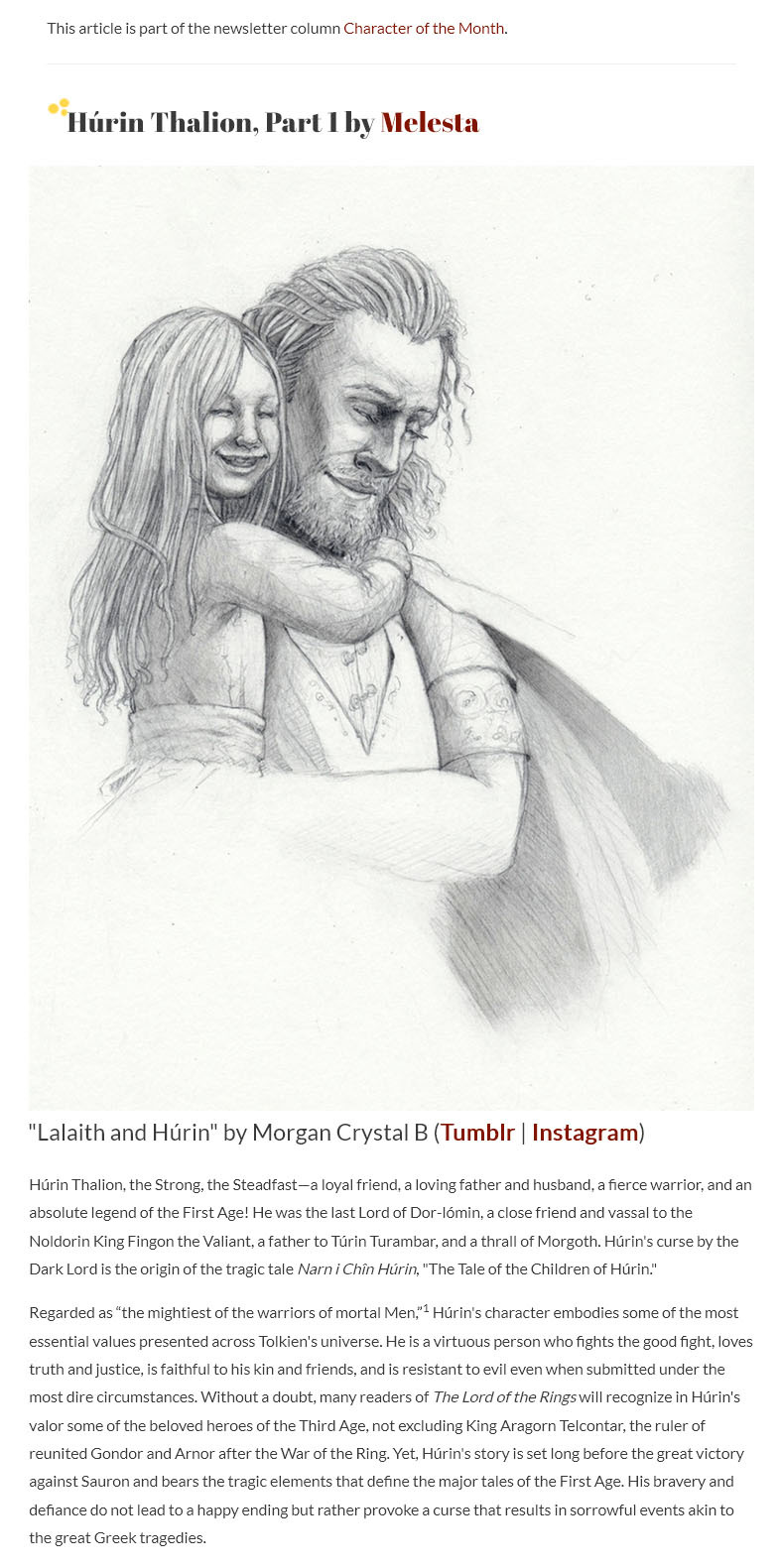
"[T]he story of Húrin, Túrin, and the dragon Glaurung remains 'a favorite tale among Men,'" writes Melesta in this month's biography of Húrin, "and I would dare say a favorite of Tolkien himself."
This "favorite tale," as Melesta documents, is one of Tolkien's oldest. Many of our character biographies document how a character evolves over the decades and myriad drafts Tolkien wrote in constructing the text that Christopher Tolkien would one day publish as The Silmarillion. Húrin, unlike many of the other early characters, is "an essential and constant thread of the tapestry of the First Age," with essential elements of his story in place from very early in the writing of the legendarium and remaining so.
But Melesta also highlights that, in Húrin, we see the first glimmers of the kind of larger-than-life heroism that would distinguish Tolkien's Third Age writings—namely The Lord of the Rings, of course—from the drearier First and Second Age materials. Yet, of course, Húrin's story comes to a tragic end, making him a fitting part of the "Silmarillion" story while also hinting at the rise of Mortals that would offer such hope later in the tales.
It is the very larger-than-life quality that requires that Húrin's story is best discussed across multiple months, so this month's biography covers the early years of Húrin's life: the making of a hero. So for this month, we can pretend to be a LotR site and enjoy Húrin's defiant hope and role model-worthy heroics before heading back to the tragic culmination of his story. You can read "Part One: The Making of a Hero" of Húrin's biography here, published by @silmarillionwritersguild
#hurin thalion#silmarillion writers guild#swg art#swg#tolkien fanart#tolkien fandom#tolkien fanworks#silmarillion fanart#character bio#character biography#tolkien meta#silmarillion meta#artists on tumblr#fanartists on tumblr#mangez-peches-art#melestasflight
9 notes
·
View notes